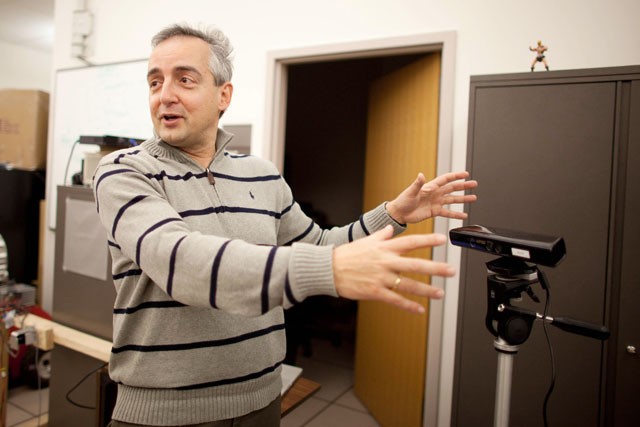Nikolaos Papanikolopoulos admits laughing at the idea of purchasing an Xbox Kinect for his $4 million research experiment.
The University of Minnesota computer science professor has saved more than $100,000 by using the Kinect as an integral part of his research âÄî employing it not as a toy but as a medical tool that could one day streamline the diagnoses of mental disorders in children.
Researchers, in a collaboration between the Institute of Child Development, the University of Minnesota Medical School and the College of Science and Engineering, are exploring the use of technology to diagnose children who show symptoms of an array of mental disorders including obsessive-compulsive disorder and attention deficit disorder.
Developed at the UniversityâÄôs Center for Distributed Robotics, the video monitoring system is comprised of several Kinect cameras stationed around a small room that take footage of a child playing with toys without intrusion.
The Kinect video feed is then sorted into data by open-sourced software, tweaked to the demands of researchers and then presented to doctors.
The Kinect is a controller-free video game device that detects usersâÄô motions.
A written assessment is commonly accepted for diagnosing mental disorders, said Sue Sexton, a St. Paul child psychologist.
However, for children younger than 6 years old, itâÄôs difficult to have the child fill out an assessment. Instead, a doctor will talk to the child as well as interview the childâÄôs parents and teachers.
In extreme cases, a doctor may observe the child in the classroom, but this is rare, said Canan Karatekin, professor of child development at the University.
Most of the time, if a child has OCD, the symptoms are very noticeable.
While Sexton herself doesnâÄôt diagnose mental disorders by observing a child, she has heard of occasions when a therapist will ask the child a series of questions in a controlled setting.
âÄúAs a doctor, you donâÄôt have tangible data,âÄù Papanikolopoulos said. âÄúWe try to provide the tools in order to back up claims of a mental disorder.âÄù
With the Kinect, Papanikolopoulos hypothesizes doctors will one day be able to receive simplified data that can help with diagnoses.
âÄúWe have found a common languageâÄù between behavioral, clinical and engineering data, said project manager Vassilios Morellas.
Initially, Papanikolopoulos envisioned purchasing a $100,000-plus system that would do similar observations of a child.
âÄúIs a $100,000 system being outsmarted by a $150 toy?âÄù Papanikolopoulos said of his initial reaction to the idea.
âÄúIndeed this is the case.âÄù
Compared to the Kinect, the more costly system required attaching sensors to the skin of the child. This could jeopardize the experiment because of the intrusive nature, Morellas said.
Leaving the child in an unobstructed state is a key to the research, he said.
âÄú[Using the Kinect] is a tremendous step forwards,âÄù Papanikolopoulos said.
After the technological kinks are figured out, PapanikolopoulosâÄô researchers will pack everything up and hand it over to the ICD, which will use it to test the hypothesis with children.
Papanikolopoulos envisions the ICD hopes to begin testing within six months.
âÄúSomething we can do three years down the line, we can do it today because of technology that was destined for the gaming industry,âÄù he said with a chuckle. âÄúI donâÄôt think Microsoft has realized that [the Kinect] is something that could change medicine.âÄù

Graduate research assistant Joshua Fasching demotrates how the Xbox Kinect system works Tuesday at the Walter Library.
Researchers ‘Kinect’ data to make faster diagnoses
The Xbox Kinect has become a U tool for diagnosing mental disorders in children.
by Frank
Published March 10, 2011
0

